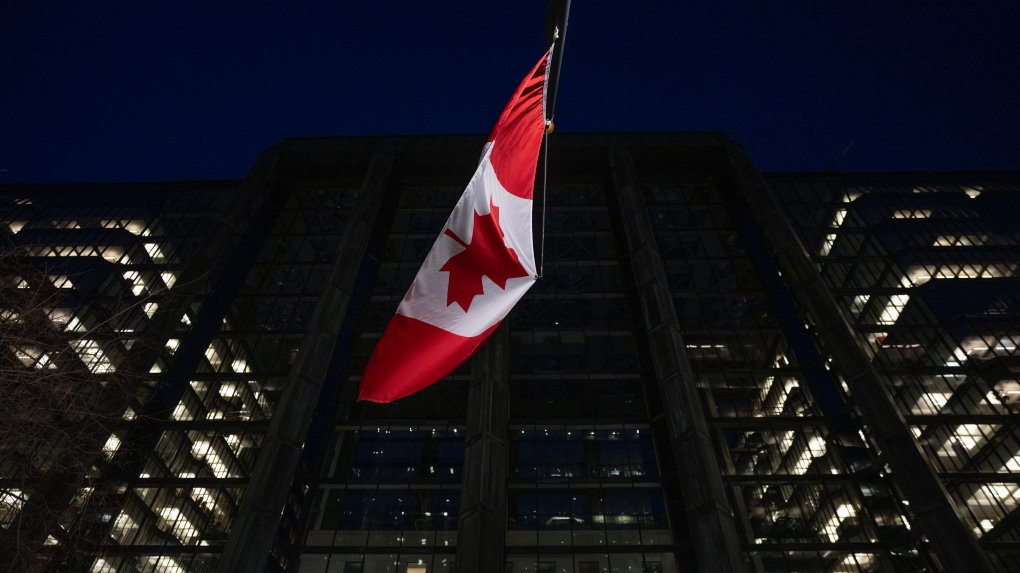Bank of Canada expected to hold interest rates this week as grey cloud hangs over economy

OTTAWA –
The Bank of Canada is expected to preach patience at its interest rate announcement this week as economists say weakening economic conditions are setting the stage for rate cuts in the coming months.
The central bank is widely expected to continue holding its key interest rate at five per cent on Wednesday, as many forecasters anticipate the first rate cut to come in around June.
But the Bank of Canada will have the opportunity to weigh in on the latest gross domestic product figures and how those affect the path for interest rates.
Economists say the slowdown in the Canadian economy is broadly in line with what the central bank was expecting — and hoping for.
“At the margin, things are looking a little bit weaker than what the Bank of Canada might have envisaged,” said Royce Mendes, managing director and head of macro strategy at Desjardins.
“Domestic spending was lower in the fourth quarter than it was in the third quarter. And that’s particularly concerning, given the fact that the population grew so dramatically during that period.”
The Canadian economy grew at an annualized rate of one per cent in the fourth quarter, which exceeded economists’ expectations and the Bank of Canada’s most recent forecast.
But the headline figure appears to be masking how weak the Canadian economy actually is.
Economic growth during the last three months of the year was driven by global factors, including strong U.S. spending trends which boosted Canadian exports.
Meanwhile, on a per-capita basis, real GDP continued to fall in the fourth quarter.
“This is probably the weakest one-per-cent growth I think any of us have lived through,” said Douglas Porter, BMO’s chief economist.
The Bank of Canada’s aggressive rate hikes are largely responsible for the economic slowdown. Consumers have reeled back spending as many of them face higher borrowing costs on their mortgages and other debt.
Companies are also feeling the pinch, as evidenced by falling business investment.
Perhaps the one outlier in the economic data has been the labour market. According Statistics Canada’s labour force survey, the unemployment rate ticked down to 5.7 per cent in January, hovering around pre-pandemic levels, while annual wage growth remained above five per cent.
However, Mendes says he’s grown skeptical of the labour force survey. He points out that payroll data from Statistics Canada suggests labour market conditions are weakening more meaningfully.
“I think the Bank of Canada is looking at all of these data in totality, and will come to the conclusion that if anything, the labour market has weakened since the time of the January monetary policy report,” he said.
The softening of the Canadian economy, along with improving supply chains, has paved the way to slower price growth.
Canada’s annual inflation rate tumbled to 2.9 per cent in January, back down in the Bank of Canada’s one to three per cent target range.
But the central bank has been clear that it won’t wave the victory flag until inflation is on a sustainable path back to two per cent.
That means inflation would have to continue steadily declining and core measures of inflation — which strip out volatile price movements — would need to follow suit.
Mendes says he’ll be watching closely to see what the central bank says about core measures of inflation, looking for a signal on where it will take its key interest rate.
The Bank of Canada has often pointed out that its two core measures of inflation are well above its target, suggesting price growth is still stubbornly high.
But Mendes’ research suggests those measures are flawed because they strip out too many components, making it harder to gauge where inflation is headed.
“At the least I expect the Bank of Canada to take a more holistic view of the inflation indicators and to acknowledge the progress that we are seeing in taming underlying inflationary pressures. If they don’t, I would take that as a very, very hawkish signal,” he said.
View original article here Source









